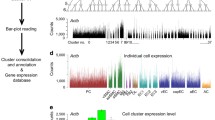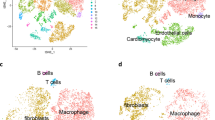Abstract
Vascular disease is one of the major causes of death worldwide. Endothelial cells are important components of the vascular structure. A better understanding of the endothelial cell changes in the development of vascular disease may provide new targets for clinical treatment strategies. Single-cell RNA sequencing can serve as a powerful tool to explore transcription patterns, as well as cell type identity. Our current study is based on comprehensive scRNA-seq data of several types of human vascular disease datasets with deep-learning-based algorithm. A gene set scoring system, created based on cell clustering, may help to identify the relative stage of the development of vascular disease. Metabolic preference patterns were estimated using a graphic neural network model. Overall, our study may provide potential treatment targets for retaining normal endothelial function under pathological situations.
Graphical abstract








Similar content being viewed by others
References
Cao Y, Fu L, Wu J et al (2022) Integrated analysis of multimodal single-cell data with structural similarity. Nucleic Acids Res 50:e121. https://doi.org/10.1093/nar/gkac781
Ding J, Regev A (2021) Deep generative model embedding of single-cell RNA-Seq profiles on hyperspheres and hyperbolic spaces. Nat Commun 12:2554. https://doi.org/10.1038/s41467-021-22851-4
Cao J, Spielmann M, Qiu X et al (2019) The single-cell transcriptional landscape of mammalian organogenesis. Nature 566:496–502. https://doi.org/10.1038/s41586-019-0969-x
Grabski IN, Street K, Irizarry RA (2023) Significance analysis for clustering with single-cell RNA-sequencing data. Nat Methods 20:1196–1202. https://doi.org/10.1038/s41592-023-01933-9
Alquicira-Hernandez J, Powell JE (2021) Nebulosa recovers single-cell gene expression signals by kernel density estimation. Bioinformatics 37:2485–2487. https://doi.org/10.1093/bioinformatics/btab003
Gu Z (2022) Complex heatmap visualization. iMeta 1:e43. https://doi.org/10.1002/imt2.43
Gu Z, Gu L, Eils R et al (2014) circlize Implements and enhances circular visualization in R. Bioinformatics 30:2811–2812. https://doi.org/10.1093/bioinformatics/btu393
Sun D, Guan X, Moran AE et al (2022) Identifying phenotype-associated subpopulations by integrating bulk and single-cell sequencing data. Nat Biotechnol 40:527–538. https://doi.org/10.1038/s41587-021-01091-3
Keenan AB, Torre D, Lachmann A et al (2019) ChEA3: transcription factor enrichment analysis by orthogonal omics integration. Nucleic Acids Res 47:W212–W224. https://doi.org/10.1093/nar/gkz446
Kolde R, Laur S, Adler P et al (2012) Robust rank aggregation for gene list integration and meta-analysis. Bioinformatics 28:573–580. https://doi.org/10.1093/bioinformatics/btr709
Alghamdi N, Chang W, Dang P et al (2021) A graph neural network model to estimate cell-wise metabolic flux using single-cell RNA-seq data. Genome Res 31:1867–1884. https://doi.org/10.1101/gr.271205.120
Li Y, Ren P, Dawson A et al (2020) Single-cell transcriptome analysis reveals dynamic cell populations and differential gene expression patterns in control and aneurysmal human aortic tissue. Circulation 142:1374–1388. https://doi.org/10.1161/CIRCULATIONAHA.120.046528
Pan H, Xue C, Auerbach BJ et al (2020) Single-cell genomics reveals a novel cell state during smooth muscle cell phenotypic switching and potential therapeutic targets for atherosclerosis in mouse and human. Circulation 142:2060–2075. https://doi.org/10.1161/CIRCULATIONAHA.120.048378
Alsaigh T, Evans D, Frankel D et al (2022) Decoding the transcriptome of calcified atherosclerotic plaque at single-cell resolution. Commun Biol 5:1084. https://doi.org/10.1038/s42003-022-04056-7
Chen K, Mou R, Zhu P et al (2023) The effect of lymphangiogenesis in transplant arteriosclerosis. Circulation 147:482–497. https://doi.org/10.1161/CIRCULATIONAHA.122.060799
Scott DJ, Allen CJ, Honstvet CA et al (2013) Lymphangiogenesis in abdominal aortic aneurysm. Br J Surg 100:895–903. https://doi.org/10.1002/bjs.9128
Yang Q, Xu J, Ma Q et al (2018) PRKAA1/AMPKalpha1-driven glycolysis in endothelial cells exposed to disturbed flow protects against atherosclerosis. Nat Commun 9:4667. https://doi.org/10.1038/s41467-018-07132-x
Zhao G, Lu H, Liu Y et al (2021) Single-cell transcriptomics reveals endothelial plasticity during diabetic atherogenesis. Front Cell Dev Biol 9:689469. https://doi.org/10.3389/fcell.2021.689469
Mahmoud AD, Ballantyne MD, Miscianinov V et al (2019) The human-specific and Smooth muscle cell-enriched LncRNA SMILR promotes proliferation by regulating mitotic CENPF mRNA and drives cell-cycle progression which can be targeted to limit vascular remodeling. Circ Res 125:535–551. https://doi.org/10.1161/CIRCRESAHA.119.314876
Hebbel RP, Wei P, Milbauer L et al (2020) Abnormal endothelial gene expression associated with early coronary atherosclerosis. J Am Heart Assoc 9:e016134. https://doi.org/10.1161/JAHA.120.016134
Monteiro JP, Rodor J, Caudrillier A et al (2021) MIR503HG loss promotes endothelial-to-mesenchymal transition in vascular disease. Circ Res 128:1173–1190. https://doi.org/10.1161/CIRCRESAHA.120.318124
Ding S, Liu J, Han X et al (2022) ICAM-1-related noncoding RNA accelerates atherosclerosis by amplifying NF-kappaB signaling. J Mol Cell Cardiol 170:75–86. https://doi.org/10.1016/j.yjmcc.2022.06.001
Fowler JWM, Zhang R, Tao B et al (2022) Inflammatory stress signaling via NF-kB alters accessible cholesterol to upregulate SREBP2 transcriptional activity in endothelial cells. Elife. https://doi.org/10.7554/eLife.79529
Rohlenova K, Veys K, Miranda-Santos I et al (2018) Endothelial cell metabolism in health and disease. Trends Cell Biol 28:224–236. https://doi.org/10.1016/j.tcb.2017.10.010
Pi X, Xie L, Patterson C (2018) Emerging roles of vascular endothelium in metabolic homeostasis. Circ Res 123:477–494. https://doi.org/10.1161/CIRCRESAHA.118.313237
Jung Y, Bang S, Choi K et al (2006) TC1 (C8orf4) enhances the Wnt/beta-catenin pathway by relieving antagonistic activity of Chibby. Cancer Res 66:723–728. https://doi.org/10.1158/0008-5472.CAN-05-3124
Zhao A, Xiao H, Zhu Y et al (2022) Omentin-1: a newly discovered warrior against metabolic related diseases. Expert Opin Ther Targets 26:275–289. https://doi.org/10.1080/14728222.2022.2037556
Wang J, Xu X, Li P et al (2021) HDAC3 protects against atherosclerosis through inhibition of inflammation via the microRNA-19b/PPARgamma/NF-kappaB axis. Atherosclerosis 323:1–12. https://doi.org/10.1016/j.atherosclerosis.2021.02.013
Missiou A, Wolf D, Platzer I et al (2010) CD40L induces inflammation and adipogenesis in adipose cells–a potential link between metabolic and cardiovascular disease. Thromb Haemost 103:788–796. https://doi.org/10.1160/TH09-07-0463
Garcia-Ramirez M, Martinez-Gonzalez J, Juan-Babot JO et al (2005) Transcription factor SOX18 is expressed in human coronary atherosclerotic lesions and regulates DNA synthesis and vascular cell growth. Arterioscler Thromb Vasc Biol 25:2398–2403. https://doi.org/10.1161/01.ATV.0000187464.81959.23
Ghatnekar A, Chrobak I, Reese C et al (2013) Endothelial GATA-6 deficiency promotes pulmonary arterial hypertension. Am J Pathol 182:2391–2406. https://doi.org/10.1016/j.ajpath.2013.02.039
Qiu J, Li M, Su C et al (2022) FOXS1 promotes tumor progression by upregulating CXCL8 in colorectal cancer. Front Oncol 12:894043. https://doi.org/10.3389/fonc.2022.894043
Rohlenova K, Goveia J, Garcia-Caballero M et al (2020) Single-cell RNA sequencing maps endothelial metabolic plasticity in pathological angiogenesis. Cell Metab 31(862–877):e814. https://doi.org/10.1016/j.cmet.2020.03.009
Wu D, Huang RT, Hamanaka RB et al (2017) HIF-1alpha is required for disturbed flow-induced metabolic reprogramming in human and porcine vascular endothelium. Elife. https://doi.org/10.7554/eLife.25217
Acknowledgements
We thank Dr. Jianming Zeng (University of Macau), and all the members of his bioinformatics team, biotrainee, for generously sharing their experience and codes.
Funding
The present study was supported by the National Natural Science Foundation of China [81970384, 82022005, 82100378]; Natural Science Foundation of Chongqing [2022NSCQ-LZX0118]; Technology Project of Sichuan Province of China [2021YFQ0061].
Author information
Authors and Affiliations
Corresponding authors
Ethics declarations
Conflict of interest
The authors declare that they have no competing interests related to this work.
Supplementary Information
Below is the link to the electronic supplementary material.
Rights and permissions
Springer Nature or its licensor (e.g. a society or other partner) holds exclusive rights to this article under a publishing agreement with the author(s) or other rightsholder(s); author self-archiving of the accepted manuscript version of this article is solely governed by the terms of such publishing agreement and applicable law.
About this article
Cite this article
Zeng, L., Liu, Y., Li, X. et al. Comprehensive scRNA-seq Model Reveals Artery Endothelial Cell Heterogeneity and Metabolic Preference in Human Vascular Disease. Interdiscip Sci Comput Life Sci 16, 104–122 (2024). https://doi.org/10.1007/s12539-023-00591-x
Received:
Revised:
Accepted:
Published:
Issue Date:
DOI: https://doi.org/10.1007/s12539-023-00591-x




